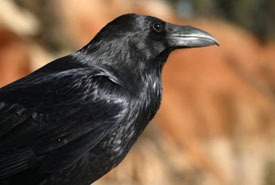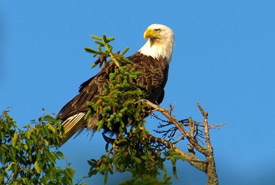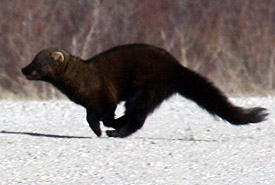Return of the raven: What the rewilding of southern Canada teaches us

Common raven (Photo by pcb21, Wikimedia Commons)
Thanks to a bird, I recently needed to change the ring tone on my mobile phone. My ring had long been the classic call of the common raven — a deep gurgling croak that reminded me of being in wilder places. Places such as the northern shores of Lake Superior or Canada’s Arctic. Places where my phone fortunately doesn’t work.
However, over the last year I’ve been finding myself at home in southern Ontario, reaching for call only to realize it was not the phone, but the real bird. A review of breeding bird atlases and population trends from Canada and the northern U.S. confirmed my observations that the range of the raven was rapidly shifting south. How had this bird of northern places followed me back to the settled areas of Canada?
The common raven is part of a pattern of rewilding migrations to southern Canada that have occurred over the last century. Bald eagles, fishers and beavers have similar homecomings. These species originally occurred in southern Canada, but retracted their ranges to northern, wilder homes.
What has caused species like ravens and beavers to begin to reclaim their altered ancestral territories? What lessons are there in their return?
Let’s start with the common raven. Ravens were probably never abundant in southern Canada, but we know they occurred regularly where there was suitable habitat. This habitat includes both physical features such as cliffs for nesting, but they are also particular about their neighbours. For a raven, big carnivores are great neighbours, especially in the winter when they leave the remains of their prey to scavenge. After European settlement, ravens vanished from much of southern Canada for over a century and retreated to only the wildest of places.
An Ontario government scientist reported in 1908 that the raven was “tolerably common in the interior of the Province (and) probably breeds in the remote forests towards James Bay.” Even as early as 1926, Percy Algernon Taverner documented in Birds of western Canada that the raven had “disappeared or is now disappearing from most of the settled parts…and is still today what it was in the beginning, a bird of the wilderness.” (Taverner, 1926).
Clearly ravens didn’t like us as neighbours, or at least what we did to the neighborhood. We cleared the mixed and deciduous forests of eastern Canada and converted the native prairies in western Canada at an astonishing rate. The large carnivores that were good raven neighbours became rare in this new landscape. Ravens were persecuted and regularly shot — seen as both a pest and a bird of ill omen. Early government reports that referred to them as “tolerably common” may have met with offence by some ravens.
Why have they returned? It’s probably because both humans and ravens have changed their attitudes about one another. As humans, we have allowed nature to return to some of the marginal lands that were farmed a century ago, and many potential nesting sites for ravens are now protected in parks and by good land use policies (such as the Niagara Escarpment Planning and Development Act in southern Ontario). We have also developed different values about ravens (and many other non-game birds).
Although ravens don’t have any form of legal protection today, their wholesale persecution has stopped. Most people are at least indifferent to them, and many people (like me and my kids) really like them.
Because of our change in attitude towards ravens, they have probably changed their attitude towards us. Ravens are very adaptable, and successfully coexist with humans in many parts of world. When we don’t shoot at them and provide some habitat, we can actually be pretty good raven neighbors.
Bald eagles have a similar history of range retraction and recent homecoming. Once occurring along most rivers and large lakes in southern Canada, they also suffered the consequences of bad neighbour relations. In addition to habitat loss and persecution, persistent toxins we released into the environment poisoned eagles and reduced the number of new eagles being born. By the 1950s bald eagles were a very rare sight in much of southern Canada.

Bald eagle (Photo by Keith Mombour)
As with ravens, bald eagles have shown that they are willing to accept us as neighbors. With the ban of DDT and other persistent toxins and protection of their habitat, eagles have made a return to southern Canada, and now regularly nest in places like Hamilton and Montreal.
Fishers are another animal once restricted to our northern wildlands that has been adapting and returning to the south. This member of the weasel family looks like a mink on steroids. Once rare and forced to retreat to the southern fringes of the boreal forest by habitat loss and unregulated trapping, the fisher has been returning to remnant forests, farmlands and even suburban backyards. I saw my first fisher tracks in southern Ontario on 1997 while doing inventories at Canadian Forces Base Borden near Barrie Ontario, and it has continued to spread south.

Fisher, Clear Creek, Riding Mountain Aspen Parkland Natural Area, Manitoba (Photo by NCC)
This wilderness mammal is proving to be more adaptable than we thought. Although we do not know the exact landscape formula that provides habitat for new fisher populations, they seem to be returning and staying in places with about one-third natural cover, good landscape connections and many large trees. Big trees are important for fishers because they use the tree cavities to rest and have their young.
Perhaps the best example of a species that was lost and then found its way back home is the beaver. I still find it hard to believe that by the late 1800s, our beaver was thought to be near extinction due to heavy unregulated trapping and, in southern Canada, habitat loss. The near loss of the beaver was instrumental in developing modern approaches to wildlife management in North America, including the need to enforce trapping seasons and harvest quotas and regular monitoring of animal populations.
Protected areas also helped the beaver to recover. One of the goals in the establishment of Algonquin Park was to provide a refuge for fur-bearing animals. Early park rangers spent much of their time patrolling for beaver poachers in the park. As beavers flourished in Algonquin Park, they began to repopulate surrounding areas, and were also live-trapped and sent to other regions to reestablish populations.
Beavers have continued to expand back into much of their former range in southern Canada, and have recently reestablished themselves in the Detroit River in southwestern Ontario along the U.S. border. People living in southern Canada today are the first to witness wild beavers in over 150 years. As with fishers, they have recovered through a combination of effective wildlife management policies and more habitat. In the case of beavers, a reduction in farming and grazing along the marginal edges of streams, rivers and wetlands have provided them with more of the young birch and aspen trees that they eat.
Common raven, fisher, bald eagle and beaver all have an important message for us. Given the chance, wild things will squeeze back into the cracks that we leave and create in between our cities and farms. Freed from unregulated exploitation and provided with a modest amount of suitable and healthy habitat, species can adapt and return.
Probably no one thought that the protection of beavers in Algonquin Park in the 1890s would eventually see them return to ravines and shores of Toronto and Detroit, or that the Niagara Escarpment Act of 1973 would support the return of the raven and fisher. But even if you never see a raven, bald eagle, fisher or beaver, we all benefit from their return. The homecoming of these wild things requires cleaner water, more open space and a gentler attitude towards our nature neighbours. They are all messengers of sustainability and well-being. This should give us hope that the habitat conservation, restoration and reconnections we do now is not just about today, but what could be.


